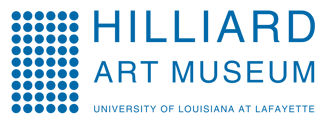Nancy Macko: The Fragile Bee
Apr 17, 2021 — Aug 25, 2021
Nancy Macko’s exhibition The Fragile Bee presents pollinator conservation as an environmental justice issue with roots in 1970s Ecofeminism. Macko’s bees are symbols of a movement that aims to undo the damage humans have wrought on our environment. Bees and other pollinators are animals we rely on. They deserve our respect because they are responsible for the vast majority of the food humans eat. In the context of Macko’s art activism, advocating for bees is equal to advocating for ourselves; doing so illustrates our interconnectedness. However, it is important to note that Macko’s work does not anthropomorphize bees, assigning them human values, which may be more myth than reality. For example, it is hard to know whether bees value hard work or favor an orderly society. Thanks to a collaboration with Mark A. Genung and his students in the Department of Biology here at the University of Louisiana at Lafayette, you will learn that bees might be better characterized as opportunistic. Furthermore, many social bee habits are controlled chemically using pheromones queen bees emit, potentially limiting bees’ ability to opt into behaviors. Acknowledging bees lack human agency to fend for themselves in the face of threats to their environment makes it easier to advocate on their behalf.
It is easy to understand how Nancy Macko’s work is relevant in a global sense, but her rich art historical lineage is complex. Artists whose work can provide interesting context for Nancy Macko’s practice include Anna Atkins, Diana Thater, and Aganetha Dyck and are part of a continuum of women artists who share similar interests. Take Anna Atkins’ seminal text British Algae: Cyanotype Impressions for example. Published in 1843, it was one of the first publications to use light-sensitive materials for illustrations as well as text (replacing the likes of engravings, lithographs, and letterpress type). Over time, Atkins’ images are now respected for their artistic value, but initially, she was most associated with using photographic means to document the world with unprecedented accuracy. Hers was a ground shaking innovation. Photography’s use within scientific and creative capacities continues today in work like Macko’s as well as Diana Thater’s. Both use photography and moving images to critique how animals and the environment are treated by humans. As the longtime Director of the Scripps College Digital Art Program, Macko is also tied to narratives associated with technological innovation. From the standpoint of subject matter, the Canadian sculptor Aganetha Dyck shares Macko’s interest in bees. Dyck is known for her work with live bees and creates sculptures by encouraging bees to build hives in forms she creates. Her interests are clearly aligned with Macko’s and understanding each of these four artists is important because they are interconnected. Their relationship within art history parallels human interconnection with honey bees in that it is complex, vital, and easily taken for granted.
Nancy Macko holds the Mary W. Johnson Professorship in Teaching at Scripps College and is the Instructional Technologist for Faculty as well. Venues that have exhibited her work over the past forty years include The Museum of the Southwest (Midland, TX), Portland Art Museum (Portland, OR), Kavli Institute for Theoretical Physics (University of California, Santa Barbara, CA), Los Angeles County Museum of Art (Los Angeles, CA), Centre International d’Art Contemporain (Pont-Aven, France), and dozens more. Her work also resides in the collections of the Fine Arts Museum of San Francisco (San Francisco, CA), Los Angeles County Museum of Art (Los Angeles, CA), Newport Art Museum (Newport, Rhode Island), Rhode Island School of Design Museum (Providence, Rhode Island), Hammer Museum (Los Angeles, CA), and the Metropolitan Museum of Art (New York, NY) among others.

